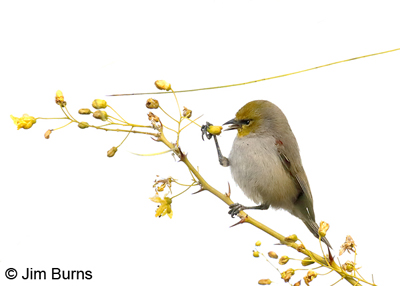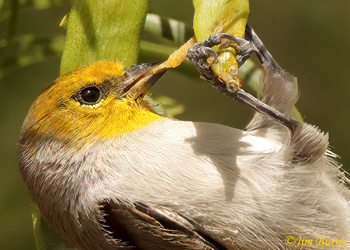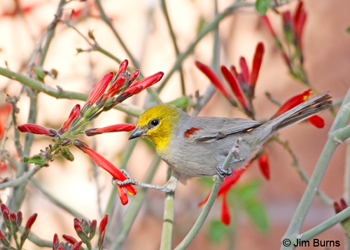
As you might guess, I first became aware of avian dexterity through my photography. Most birders have seen photos or are at least aware of our raptors, both diurnal and nocturnal, using their talons to rip into carcasses and transfer food to beaks with those talons—Osprey with fish, falcons with rodents, and small owls with grasshoppers and moths. It just seems logical that birds of prey would instinctively use their feet as they feed because the talons are used for the capture itself.
Small birds, insectivores and frugivores, not so much, probably because we don’t observe them as well or “admire” them in the same way we do raptors. I first realized how physically adroit Verdins are when I posted a picture of one closely inspecting the bud of a Palo Verde tree it had pulled closer with its right foot as it clung to the branch with its left. It was taken on an overcast day, every detail of the branch stark against a white background without the clutter of other foliage behind it.
My friend, Brendon Grice, supplied a perfect caption—“Testing, testing . . . is this thing working?”—hilarious for sure, but when I looked at the photo again I realized it also perfectly illustrated the much overlooked and underappreciated way evolution has equipped our small passerines to go about their everyday business of survival. Since they have one toe pointed backward, three pointed forward, their feet are perfectly suited for grasping, pulling, and maneuvering food items. This image sent me to my photo archives where I discovered several other fascinating examples of Verdin dexterity.
The Verdin diet consists mainly of insects during breeding season, fruits, seeds, and nectar fall through spring. Here is a partial list of images I have of Verdin gymnastics, one foot clutching a limb while using the other to: secure a hackberry seed to a branch; hold a chuparosa blossom close enough to pierce the base of its corolla for nectar; hang upside down to inspect a wolfberry bush’s leaves for caterpillars; balance on a vertical ironwood twig to feed a scale insect to a juvenile; hang from an individual mesquite bean pod as it extracts a caterpillar. Don’t try any of this at home.
I also have a spectacular Verdin sequence which makes me wish I had been a videographer. The bird is plucking ripe purple berries from a Fan Palm tree while hanging upside down. It inadvertently drops a berry from its bill, immediately releases its hold on the bunch, plummets downward head first, and catches the berry in its beak before it hit the ground. That’s gold medal dexterity.
Within the human species smaller people tend to be more lithe and supple than larger ones. Perhaps this is true in the avian world as well, but Verdins, because of their small size and unremarkable plumage and song seem to go relatively unnoticed by birders. Verdins’ physical attributes and the skill with which they survive are generally underappreciated. This is just another reason for birders to spend more time observing even our more common species.
It would possibly come as no surprise if I told you I have a photo of a perched Bald Eagle at Bosque del Apache plucking two coots, one in each claw. That capture would have been something to see, but could an eagle catch a Verdin? Of course not. Verdins glean for spiders and insects so small they can’t be seen in photos without a full screen blow-up. We all need to slow down, narrow our focus, and drill deeper to discover even our smallest, least imposing species are capable of impressive, even, amazing behavior.
Verdin on Mesquite bean pod |
Verdin in Chuparosa |

